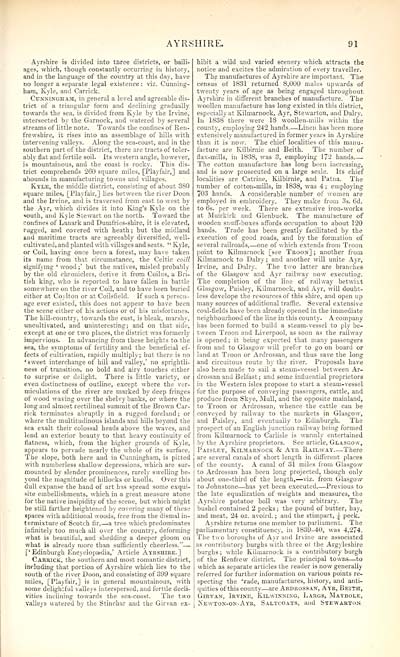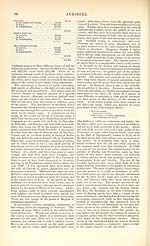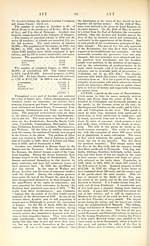Download files
Complete book:
Individual page:
Thumbnail gallery: Grid view | List view

AYRSHIRE.
91
Ayrshire is divided into tnree districts, or baili-
ages, which, though constantly occurring in history,
and in the language of the country at this day, have
no longer a separate legal existence : viz. Cunning-
ham, Kyle, and Carrick.
Cunningham, in general a level and agreeable dis-
trict of a triangular form and declining gradually
towards the sea, is divided from Kyle by the Irvine,
intersected by the Garnock, and watered by several
streams of little note. Towards the confines of Ren-
frewshire, it rises into an assemblage of hills with
intervening valleys. Along the sea-coast, and in the
southern part of the district, there are tracts of toler-
ably flat and fertile soil. Its western angle, however,
is mountainous, and the coast is rocky. This dis-
trict comprehends "260 square miles, [Playfair,] and
abounds in manufacturing towns and villages.
Kyle, the middle district, consisting of about 380
square miles, [Playfair,] lies between the river Doon
and the Irvine, and is traversed from east to west by
the Ayr, which divides it into King's Kyle on the
south, and Kyle Stewart on the north. Toward the
confines of Lanark and Dumfries-shire, it is elevated,
rugged, and covered with heath; but the midland
and maritime tracts are agreeably diversified, well-
cultivated, and planted with villages and seats. " Kyle,
or Coil, having once been a forest, may have taken
its name from that circumstance, the Celtic colli
signifying ' wood ;' but the natives, misled probably
by the old chroniclers, derive it from Coilus, a Bri-
tish king, who is reported to have fallen in battle
somewhere on the river Coil, and to have been buried
either at Coylton or at Coilsfield. If such a perscn-
age ever existed, this does not appear to have been
the scene either of his actions or of his misfortunes.
The hill-country, towards the east, is bleak, marshy,
uncultivated, and uninteresting; and on that side,
except at one or two places, the district was formerly
impervious. In advancing from these heights to the
sea, the symptoms of fertility and the beneficial ef-
fects of cultivation, rapidly multiply; but there is no
'sweet interchange of hill and valley,' no sprightli-
ness of transition, no bold and airy touches either
to surprise or delight. There is little variety, or
even distinctness of outline, except where the ver-
miculations of the river are marked by deep fringes
of wood waving over the shelvy banks, or where the
long and almost rectilineal summit of the Brown Car.
rick terminates abruptly in a rugged foreland; or
where the multitudinous islands and hills beyond the
sea exalt their colossal heads above the waves, and
lend an exterior beauty to that heavy continuity of
flatness, which, from the higher grounds of Kyle,
appears to pervade nearly the whole of its surface.
The slope, both here and in Cunningham, is pitted
with numberless shallow depressions, which are sur-
mounted by slender prominences, rarely swelling be-
yond the magnitude of hillocks or knolls. Over this
dull expanse the hand of art has spread some exqui-
site embellishments, which in a great measure atone
tor the native insipidity of the scene, but which might
be still farther heightened by covering many of tliese
6paces with additional woods, free from the dismal in-
termixture of Scotch fir, — a tree which predominates
infinitely too much all over the country, deforming
what is beautiful, and shedding a deeper gloom on
what is already more than sufficiently cheerless." —
['Edinburgh Encyclopaedia,' Article Ayrshire.]
Carrick, the southern and most romantic district,
including that portion of Ayrshire which lies to the
south of the river Doon, and consisting of 399 square
miles, [Playfair,] is in general mountainous, with
some delightful valleys interspersed, and fertile decli-
vities inclining towards the sea-coast. The two
valleys watered by the Stinchar and the Girvan ex-
hibit a wild and varied scenery which attracts the
notice and excites the admiration of every traveller.
The manufactures of Ayrshire are important. The
census of 1831 returned S,000 males upwards of
twenty years of age as being engaged throughout.
Ayrshire in different branches of manufacture. The
woollen manufacture has long existed in this district,
especially at Kilmarnock, Ayr, Stewarton, and Dairy.
In 1838 there were 18 woollen-mills within the
county, employing 242 hands. — Linen has been more
extensively manufactured in former years in Ayrshire
than it is now. The chief localities of this manu-
facture are Kilbirnie and Beith. The number of
flax-mills, in 183S, was 3, employing 172 hands
The cotton manufacture has long been increasing,
and is now prosecuted on a large scale. Its chief
localities are Catrine, Kilbirnie, and Patna. The
number of cotton-mills, in 1838, was 4 ; employing
703 hands. A considerable number of women are
employed in embroidery. They make from 3s. 6d.
to 6s. per week. There are extensive iron-works
at Muirkirk and Glenbuck. The manuiacture of
wooden snuff-boxes affords occupation to about 120
hands. Trade has been greatly facilitated by the
execution of good roads, and by the formation of
several railroads, — one of which extends from Troon,
point to Kilmarnock [see Troon] ; another from
Kilmarnock to Dairy ; and another will unite Ayr,
Irvine, and Dairy. The two latter are branches-
of the Glasgow and Ayr railway now executing.
The completion of the line of railway betwixt
Glasgow, Paisley, Kilmarnock, and Ayr, will doubt-
less develope the resources of this shire, and open up
many sources of additional traffic. Several extensive
coal-fields have been already opened in the immediate
neighbourhood of the line in this county. A company
has been formed to build a steam- vessel to ply be-
tween Troon and Liverpool, as soon as the railway
is opened ; it being expected that many passengers
from and to Glasgow will prefer to go on board or
land at Troon or Ardrossan, and thus save the long
and circuitous route by the river. Proposals have
also been made to sail a steam-vessel between Ar-
drossan and Belfast ; and some influential proprietors
in the Western isles propose to start a steam-vessel
for the purpose of conveying passengers, cattle, and
produce from Skye, Mull, and the opposite mainland,
to Troon or Ardrossan, whence the cattle can be
conveyed by railway to the markets in Glasgow,
and Paisley, and eventually to Edinburgh. The
prospect of an English junction railway being formed
from Kilmarnock to Carlisle is warmly entertained
by the Ayrshire proprietors. See article, Glasgow,
Paisley, Kilmarnock & Ayr Railway — There
are several canals of short length in different places
of the county. A canal of 31 miles from Glasgow
to Ardrossan has been long projected, though only
about one-third of the length, — viz. from Glasgow
to Johnstone — has yet been executed Previous to
the late equalization of weights and measures, the
Ayrshire potatoe boll was very arbitrary. The
bushel contained 2 pecks; the pound of butter, hay,
and meat, 24 oz. avoird. ; and the stimpart, A peck.
Ayrshire returns one member to parliament. The
parliamentary constituency, in 1839-40, was 4,274.
The two boroughs of Ayr and Irvine are associated
as contributory burghs with three or the Argyleshire
burghs ; while Kilmarnock is a contributory burgh
of the Renfrew district. The principal towns — to
which as separate articles the reader is now generally
referred for further information on various points re-
specting the ''rade, manufactures, history, and anti-
quities of this county — are Ardrossan, Ayr, Beith,
Girvan, Irvine, Kilwinning, Largs, Maybole,
Xewton-on-Ayr, Saltcoats, and Stewarton
91
Ayrshire is divided into tnree districts, or baili-
ages, which, though constantly occurring in history,
and in the language of the country at this day, have
no longer a separate legal existence : viz. Cunning-
ham, Kyle, and Carrick.
Cunningham, in general a level and agreeable dis-
trict of a triangular form and declining gradually
towards the sea, is divided from Kyle by the Irvine,
intersected by the Garnock, and watered by several
streams of little note. Towards the confines of Ren-
frewshire, it rises into an assemblage of hills with
intervening valleys. Along the sea-coast, and in the
southern part of the district, there are tracts of toler-
ably flat and fertile soil. Its western angle, however,
is mountainous, and the coast is rocky. This dis-
trict comprehends "260 square miles, [Playfair,] and
abounds in manufacturing towns and villages.
Kyle, the middle district, consisting of about 380
square miles, [Playfair,] lies between the river Doon
and the Irvine, and is traversed from east to west by
the Ayr, which divides it into King's Kyle on the
south, and Kyle Stewart on the north. Toward the
confines of Lanark and Dumfries-shire, it is elevated,
rugged, and covered with heath; but the midland
and maritime tracts are agreeably diversified, well-
cultivated, and planted with villages and seats. " Kyle,
or Coil, having once been a forest, may have taken
its name from that circumstance, the Celtic colli
signifying ' wood ;' but the natives, misled probably
by the old chroniclers, derive it from Coilus, a Bri-
tish king, who is reported to have fallen in battle
somewhere on the river Coil, and to have been buried
either at Coylton or at Coilsfield. If such a perscn-
age ever existed, this does not appear to have been
the scene either of his actions or of his misfortunes.
The hill-country, towards the east, is bleak, marshy,
uncultivated, and uninteresting; and on that side,
except at one or two places, the district was formerly
impervious. In advancing from these heights to the
sea, the symptoms of fertility and the beneficial ef-
fects of cultivation, rapidly multiply; but there is no
'sweet interchange of hill and valley,' no sprightli-
ness of transition, no bold and airy touches either
to surprise or delight. There is little variety, or
even distinctness of outline, except where the ver-
miculations of the river are marked by deep fringes
of wood waving over the shelvy banks, or where the
long and almost rectilineal summit of the Brown Car.
rick terminates abruptly in a rugged foreland; or
where the multitudinous islands and hills beyond the
sea exalt their colossal heads above the waves, and
lend an exterior beauty to that heavy continuity of
flatness, which, from the higher grounds of Kyle,
appears to pervade nearly the whole of its surface.
The slope, both here and in Cunningham, is pitted
with numberless shallow depressions, which are sur-
mounted by slender prominences, rarely swelling be-
yond the magnitude of hillocks or knolls. Over this
dull expanse the hand of art has spread some exqui-
site embellishments, which in a great measure atone
tor the native insipidity of the scene, but which might
be still farther heightened by covering many of tliese
6paces with additional woods, free from the dismal in-
termixture of Scotch fir, — a tree which predominates
infinitely too much all over the country, deforming
what is beautiful, and shedding a deeper gloom on
what is already more than sufficiently cheerless." —
['Edinburgh Encyclopaedia,' Article Ayrshire.]
Carrick, the southern and most romantic district,
including that portion of Ayrshire which lies to the
south of the river Doon, and consisting of 399 square
miles, [Playfair,] is in general mountainous, with
some delightful valleys interspersed, and fertile decli-
vities inclining towards the sea-coast. The two
valleys watered by the Stinchar and the Girvan ex-
hibit a wild and varied scenery which attracts the
notice and excites the admiration of every traveller.
The manufactures of Ayrshire are important. The
census of 1831 returned S,000 males upwards of
twenty years of age as being engaged throughout.
Ayrshire in different branches of manufacture. The
woollen manufacture has long existed in this district,
especially at Kilmarnock, Ayr, Stewarton, and Dairy.
In 1838 there were 18 woollen-mills within the
county, employing 242 hands. — Linen has been more
extensively manufactured in former years in Ayrshire
than it is now. The chief localities of this manu-
facture are Kilbirnie and Beith. The number of
flax-mills, in 183S, was 3, employing 172 hands
The cotton manufacture has long been increasing,
and is now prosecuted on a large scale. Its chief
localities are Catrine, Kilbirnie, and Patna. The
number of cotton-mills, in 1838, was 4 ; employing
703 hands. A considerable number of women are
employed in embroidery. They make from 3s. 6d.
to 6s. per week. There are extensive iron-works
at Muirkirk and Glenbuck. The manuiacture of
wooden snuff-boxes affords occupation to about 120
hands. Trade has been greatly facilitated by the
execution of good roads, and by the formation of
several railroads, — one of which extends from Troon,
point to Kilmarnock [see Troon] ; another from
Kilmarnock to Dairy ; and another will unite Ayr,
Irvine, and Dairy. The two latter are branches-
of the Glasgow and Ayr railway now executing.
The completion of the line of railway betwixt
Glasgow, Paisley, Kilmarnock, and Ayr, will doubt-
less develope the resources of this shire, and open up
many sources of additional traffic. Several extensive
coal-fields have been already opened in the immediate
neighbourhood of the line in this county. A company
has been formed to build a steam- vessel to ply be-
tween Troon and Liverpool, as soon as the railway
is opened ; it being expected that many passengers
from and to Glasgow will prefer to go on board or
land at Troon or Ardrossan, and thus save the long
and circuitous route by the river. Proposals have
also been made to sail a steam-vessel between Ar-
drossan and Belfast ; and some influential proprietors
in the Western isles propose to start a steam-vessel
for the purpose of conveying passengers, cattle, and
produce from Skye, Mull, and the opposite mainland,
to Troon or Ardrossan, whence the cattle can be
conveyed by railway to the markets in Glasgow,
and Paisley, and eventually to Edinburgh. The
prospect of an English junction railway being formed
from Kilmarnock to Carlisle is warmly entertained
by the Ayrshire proprietors. See article, Glasgow,
Paisley, Kilmarnock & Ayr Railway — There
are several canals of short length in different places
of the county. A canal of 31 miles from Glasgow
to Ardrossan has been long projected, though only
about one-third of the length, — viz. from Glasgow
to Johnstone — has yet been executed Previous to
the late equalization of weights and measures, the
Ayrshire potatoe boll was very arbitrary. The
bushel contained 2 pecks; the pound of butter, hay,
and meat, 24 oz. avoird. ; and the stimpart, A peck.
Ayrshire returns one member to parliament. The
parliamentary constituency, in 1839-40, was 4,274.
The two boroughs of Ayr and Irvine are associated
as contributory burghs with three or the Argyleshire
burghs ; while Kilmarnock is a contributory burgh
of the Renfrew district. The principal towns — to
which as separate articles the reader is now generally
referred for further information on various points re-
specting the ''rade, manufactures, history, and anti-
quities of this county — are Ardrossan, Ayr, Beith,
Girvan, Irvine, Kilwinning, Largs, Maybole,
Xewton-on-Ayr, Saltcoats, and Stewarton
Set display mode to: Large image | Transcription
Images and transcriptions on this page, including medium image downloads, may be used under the Creative Commons Attribution 4.0 International Licence unless otherwise stated. ![]()
| Gazetteers of Scotland, 1803-1901 > Topographical, statistical, and historical gazetteer of Scotland > Volume 1 > (171) Page 91 |
|---|
| Permanent URL | https://digital.nls.uk/97439598 |
|---|
| Description | Volume first. A-H. |
|---|---|
| Attribution and copyright: |
|

